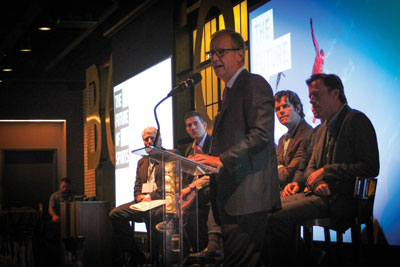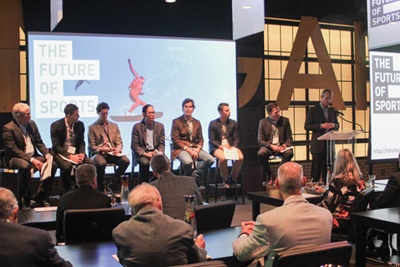Jeremy Jacobs Sr. had heard enough.
The longtime chairman of Delaware North Cos. and TD Garden and owner of the Boston Bruins was sitting in his regular Monday staff meeting, where ideas and concepts were volleyed back and forth. He grew frustrated that such thought was being wasted.
“We talk about all these great ideas for services or experiences, and we’re interested in them as an organization,” he told me. “But too often what comes out of these great thoughts is just smoke with no roots. Finally, I said, ‘Why aren’t we putting these together in some form and sharing these thoughts with clients and friends? That will move the needle faster.’”
The chairman’s directive spurred action, and a project led by his three sons recruited futurists to offer a blueprint of the next 25 years in society and sports.
The commissioned study, “The Future of Sports,” written by a number of noted futurists, including Po Bronson and Ethan Watters, was central to a fascinating discussion held at TD Garden on a sunny September day in Boston’s North End.
 |
Jerry Jacobs Jr. discusses the study, “The Future of Sports.”
Photo by: DELAWARE NORTH COS.
|
Delaware North invited more than 100 executives, including NHL Commissioner
Gary Bettman, Celtics co-owner
Stephen Pagliuca and Red Sox President and CEO
Larry Lucchino, to listen, engage and peek into the future. Attendees were asked to bring an open mind, check skepticism at the door and embrace change.
“Discussing the future of our industry can be anxiety-provoking, simply because so much seems uncertain,” Jacobs wrote in the study. “No one wants to bet on the wrong trend.”
During a panel discussion and over lunch at TD Garden’s Legends club, the boundaries of sport, commerce, physical makeup, athlete performance and the fan experience were explored, sometimes through a frightening lens.
Yobie Benjamin, former Citigroup global CTO, was the most provocative speaker, saying right out of the gate that teams and organizations could have millions in new revenue immediately through “player point-of-view” cameras that offered subscription-based content for hard-core fans to see exactly what the players see. “This player point-of-view technology exists today and can be delivered next season,” he exclaimed, without bringing up any rights, intellectual property or technology challenges. In the future, the panelists agreed, fans will experience game action through virtual reality headsets, with one watching from the perspective of their favorite quarterback while a buddy watches from the viewpoint of the running back.
Benjamin encouraged IP rights holders to embrace user-generated content at events. “Look at it this way. You have 20,000 cameras in the stadium. Make them work for you and make them part of your distribution. Find a way to share revenue with fans who share content on YouTube,” he said.
The belief was that “broadcast” would disappear from our vernacular as all fans will create personalized experiences and content to be packaged and sold; Snapchat’s “Live Stories” feature is an example that gives users the feeling of being at an event through authentic content.
When “cutting the cord” came up, attendees were implored to move away from that term because of its negative connotation. The ability for audiences to find content on other distribution platforms will not stifle growth, they stressed, but instead enhance it. When an audience moves, IP holders were implored to move with them.
 |
Delaware North’s Charlie Jacobs introduces the panel of futurists
at TD Garden.
Photo by: DELAWARE NORTH COS.
|
The in-venue experience would be in mega-multipurpose venues that can handle 250,000 fans, as arenas and stadiums extend outward to enhance ways fans can experience games. Predictions of open-concept venues providing tiers of access and tailgating moved inside the gates were based on self-driving and self-parking cars freeing up real estate.
For those not at the game, panelists saw the potential of holographic displays of live events, with fans sitting in venues watching holographic displays of games. They cited the example of Coachella in 2012 when the late Tupac Shakur was featured via hologram in joining Snoop Dogg for two songs.
But the most disturbing part of the discussion, which resulted in the most debate, came when predicting the creation of the “super athlete” — the combination of an innately talented athlete who is genetically enhanced. The ability of an athlete to manipulate his or her body will be dramatically increased and proved safe, the futurists stressed.
“For the athlete, new genetic therapy will be available to make their bones unbreakable and their brains less susceptible to concussions. These advances will pave the way for huge jumps in performance — and a global debate over theoretical limits of enhancements,” the report stated. Such a disturbing concept led Bettman to ask a question from the audience about the true essence of sport and if that is lost by such genetically enhanced alterations. All agreed it would lead to a social debate about fairness, safety and competitive integrity, as the line between artificial and natural body parts blurs. Benjamin exclaimed, “Medical democratization will be here faster than you think. It’s not out of the question that you could have two leagues — one with modified athletes and one with stock athletes.” The room buzzed — who wouldn’t want to see whether natural humans can beat ones developed in the lab. It’s “Rocky IV,” Balboa vs. Drago, all over again.
Over plates of sole and roasted chicken at lunch, guests cringed at the possibilities — and implications — of such biological enhancements. Some foresaw early genetic testing of kids to determine whether they had a true future as a professional, or overbearing parents doing anything biologically possible to make their child a top athlete.
All of these advancements — if they are that — are based on technology. “The primary driver of all this accelerating change, Moore’s Law — the doubling of computer power every 18 months — will give way to quantum computing,” the report states. It was stressed that if organizations aren’t drifting over into the fast lane of technology advancements, they are losing out. Many technology experiments will fail, but panelists implored those in the audience to take more shots on goal because technology is cheaper.
I followed up with Jacobs, who was unable to attend the event in Boston, to talk about the report and the vision of the future. We both marveled and cringed at some of the findings.
“It was really about getting the ideas flowing more than application,” he said. “Some of these theories are absolutely nuts and nonapplicable. But if you don’t have them, you’re going to miss a potential jewel. Maybe it’s something you come back to it in six months or six years and it is applicable.”
The plan is to share their report and build on it. “I see this as a social need that exists,” he said. “There are these minds out there and so if you have an issue, you can ask them, ‘How would you handle this? What do you think?’ You may find some ideas to take to the next step.”
For Jacobs, who has spent a lifetime in the sports and hospitality business, he finds it healthy to bring in new thinking.
“We need to open up our brains and expose more people to new ideas and people’s experiences,” he said. “We should be taking all those into consideration as we plan our businesses. I truly believe we are making our staff better by exposing them to these ideas and thoughts.”
“I want people around me to be flexible,” the 75-year-old said with a laugh before signing off, “and not as stodgy as I am.”
Abraham D. Madkour can be reached at amadkour@sportsbusinessjournal.com.






